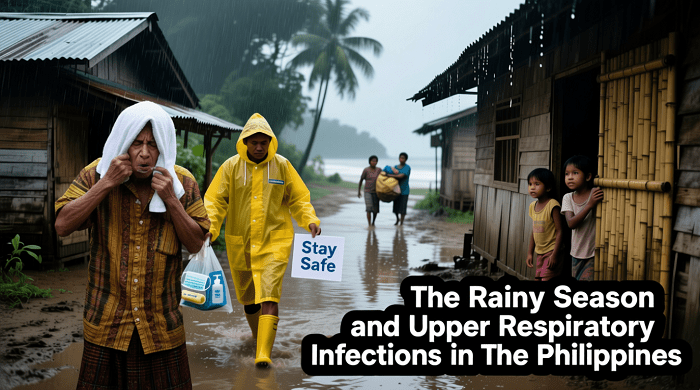The Rainy Season and Upper Respiratory Infections in the Philippines
When the rainy season hits the Philippines with more floods, it brings Upper Respiratory Infections. These infections are among the most common illnesses that Filipinos experience during and after heavy rains and floods. Damp environments, overcrowded evacuation centers, and sudden temperature changes create the perfect breeding ground. These conditions are ideal for bacteria and viruses.
In recent weeks, continuous downpours have caused severe flooding in many parts of the country. This is especially true for Metro Manila, (including our Helal Medical Office front), Bulacan, Pampanga, and other areas. These floods not only damage property but also create ideal conditions for viruses and bacteria to thrive. This leads to an increase in respiratory illnesses.
What Are Upper Respiratory Infections (URIs)?
Upper Respiratory Infections (URIs) refer to infections that affect the nose, throat, and airways. They are usually caused by viruses, though bacteria can sometimes be the culprit. Common types of URIs include:
- Common Cold (Sipon in Tagalog)
- Sinusitis (Sinus infection)
- Pharyngitis (Sore throat)
- Laryngitis (Inflamed voice box)
- Tonsillitis
- Acute Bronchitis
During the rainy and flooded months, the number of URI cases tends to rise. This is due to the cold, humid conditions. There is also close human contact in evacuation centers and flooded communities.
How Heavy Rains and Floods Trigger Upper Respiratory Infections
Floods and prolonged rainy weather create a perfect environment for viruses and bacteria to spread. Here’s how:
- Cold, Damp Air Weakens the Immune System
Sudden drops in temperature can lower the body’s immune defenses. This condition makes it easier for pathogens to invade. - Poor Ventilation in Crowded Shelters
During floods, many Filipinos are forced to stay in evacuation centers or crowded homes. Viruses can spread easily through coughing and sneezing in these environments. - Contaminated Air and Water
Floodwaters often carry waste, chemicals, and disease-causing organisms. When inhaled or ingested, they can lead to infections. - Mold Growth in Flooded Homes
Damp conditions promote mold and mildew. These release spores that can irritate the respiratory system. This is especially worrying among children and persons of old age. - Exposure to Cold Rain and Wet Clothes
Walking in floodwaters for hours can lower body temperature. It can trigger colds or bronchitis. Working while drenched has the same effect.
Common Symptoms to Watch Out For
If you or your family members have been exposed to rain or floods, be alert for these symptoms:
- Sneezing, runny or stuffy nose
- Sore throat or hoarse voice
- Cough (dry or productive)
- Mild fever or chills
- Headache or facial pain
- Fatigue or body aches
- Shortness of breath (in more serious cases)
While many URIs are mild and self-limiting, some can develop into pneumonia or severe bronchitis. This is especially true in children, older adults, and those with asthma or weak immune systems.
How to Prevent Upper Respiratory Infections During Flood Season
- Stay Dry and Warm
Always bring an umbrella, raincoat, and waterproof footwear. Change out of wet clothes immediately to prevent chills. - Wear Face Masks in Crowded Areas
Masks can reduce exposure to viruses, especially in evacuation centers or hospitals. - Maintain Good Hygiene
Wash your hands regularly with soap and clean water (or alcohol-based sanitizer) to avoid spreading germs. - Boost Your Immune System
Eat nutritious meals rich in vitamin C, zinc, and antioxidants. Get enough rest and hydration. - Clean and Disinfect Your Home After Floods
Dry out damp areas. Clean moldy surfaces with disinfectants. This will prevent respiratory irritation. - Avoid Floodwater When Possible
Floodwaters contain sewage and chemicals. These contaminants can cause respiratory illnesses. They can also lead to leptospirosis and skin infections. - Use Air Purifiers or Keep Windows Open (When Safe)
Improve air circulation to reduce viral load and indoor humidity.
When to see a doctor or contact us at Helal Medical
Seek medical attention if:
- Your fever lasts more than 3 days.
- You have difficulty breathing or chest pain.
- You cough up green or bloody mucus.
- Your child has high fever or is unusually drowsy.
- Symptoms persist or worsen despite home care.
For Filipinos in flood-affected areas, Barangay Health Centers and local government units (LGUs) often provide free checkups and medicines.
For more guidance, you can refer to the Department of Health (DOH) website for health advisories during disasters:
👉 Department of Health – Health Emergency Management Bureau
You can also visit the World Health Organization (WHO) Philippines page for up-to-date information on communicable diseases during floods:
👉 WHO Philippines: Health and Natural Disasters
Treatment and Recovery
Most viral URIs resolve within 7–10 days with rest, hydration, and symptom relief. Here are some helpful home remedies:
- Drink plenty of warm fluids (water, soup, or calamansi juice). for this purpose, we planted a Calamansi tree in my house garden!
- Gargle with warm salt water to soothe sore throat.
- Use a humidifier to keep airways moist.
- Take paracetamol or ibuprofen for fever and pain relief.
- Get adequate sleep and avoid overexertion.
If prescribed, antibiotics should only be taken when a doctor confirms a bacterial infection—not for viral colds or flu.
The Bigger Picture
The increasing frequency of floods and extreme weather in the Philippines highlights the importance of public health preparedness. Simple actions— as proper hygiene, safe shelter management, and early medical consultation—can prevent thousands of URI cases every year.
Government agencies and local communities must work together to:
- Improve drainage and flood management systems.
- Offer clean evacuation shelters with proper ventilation.
- Educate the public on health risks during rainy months.
Final Thoughts
The rainy and flood season in the Philippines is more than just an inconvenience. It’s a period when upper respiratory infections spread rapidly. This is especially true among vulnerable groups. By staying informed, Filipinos can protect themselves and their families. Practicing preventive measures helps in this protection as well. Seeking prompt medical care is essential to shield against these common but preventable illnesses.
🌿 If you experience a persistent cough, fever, or difficulty breathing after rain or flood exposure, seek help promptly. If symptoms occur, obtain medical assistance right away. Consult your nearest healthcare provider right away. Don’t ignore early symptoms—prevention and early treatment save lives. Stay safe, stay dry, and protect your lungs this rainy season! 🌧️💪




